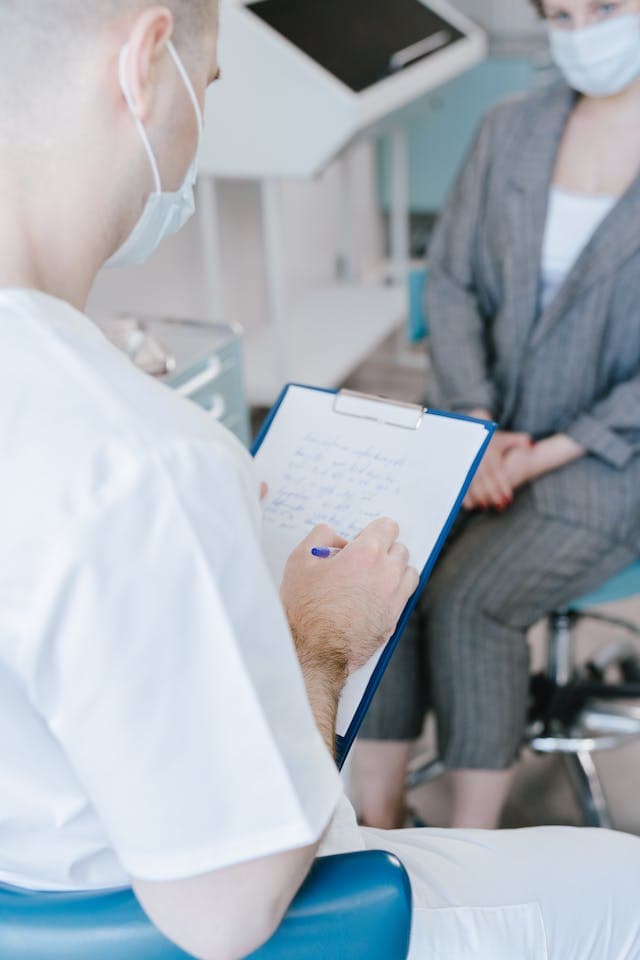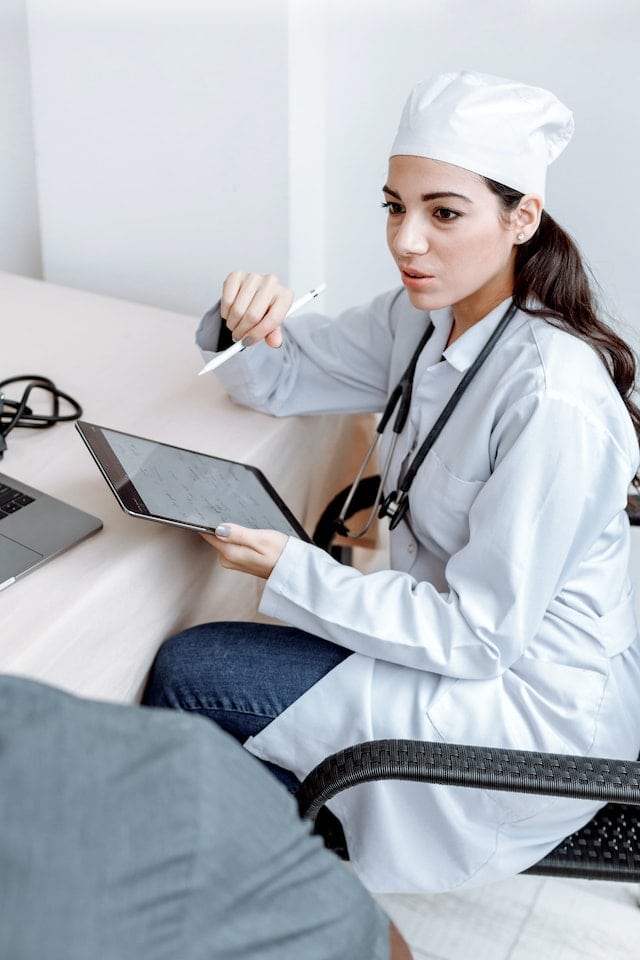Knee Ligaments Analysed: ACL & PCL
Tibial Movement: Anterior & Posterior Translation
Genourob redefines knee diagnostics with the GNRB arthrometer. Harnessing precision for both ACL/PCL tests, it's the epitome of innovation in knee stability assessment. With the GNRB's dual-functionality, orthopedic surgeons, radiologists, physiotherapists, and sports doctors can now swiftly detect and address ligament injuries, ensuring comprehensive care and streamlined diagnostics for optimal patient outcomes.
Table of Contents

GNRB With PCL Option Arthrometer Features
- Medical Device: High-Tech Robotic Knee Laxity Arthrometer
- Knee Dynamic Assessments Performed:
- Application of Anterior Tibial Translations to measure the state of resistance of the ACL.
- Application of Posterior Tibial Translations to measure the state of resistance of the PCL.
- Software: LDA Software – A user-friendly software developed by Genourob for optimal objective testing of the knee ligaments with an easy to access exportable database.
- Population: Wide range of normative data, from pediatric through adults, ages 8 – 100.
- After Sale: Excellent after-sale support, installation and continuing education programs.
- Warranty: 2 year-warranty.
- Shipment: Worldwide.
Dyneelax Arthrometer
1) ACL Diagnosis
2) ACL Prevention
3) ACL Rehabilitation
4) ACL Follow-up
The GNRB Knee Laxity Arthrometer with PCL option stands at the forefront of medical technology designed for identifying, managing, rehabilitating, and monitoring patients with knee ligament issues. This sophisticated instrument provides accurate assessments of knee instability by performing automated anterior and posterior drawer tests, targeting both the anterior cruciate ligament (ACL) and the posterior cruciate ligament (PCL).
Differing from conventional arthrometers, the GNRB facilitates automated tibial movements in anterior and posterior. This advanced method gives a comprehensive and precise evaluation of knee joint stability. Notably, in the detection of partial ACL tears, the GNRB offers superior performance over MRI techniques, ensuring top-notch diagnostic precision and fostering a tailored therapeutic strategy for patients.
What is GNRB?
Discover unmatched precision in knee ligament evaluation using GNRB: a harmonious blend of accuracy and ease, setting a new benchmark in ligament diagnosis & therapy.
Sensitivity: A Recent study (DOI: 10.1016/j.knee.2023.03.017) has shown GNRB & Dyneelax arthrometers exhibit superior sensitivity in diagnosing partial ACL ruptures. Where MRIs might miss or misinterpret the minutiae of a partial rupture, these arthrometers catch them.
Why Arthrometers Over MRI?
Cost-Efficient Diagnosis (90% Cost Reduction)
Economic benefits with reduced costs for both practitioners and patients.
Instantaneous & More Accurate Diagnostics
Immediate & accurate results about the state of resistance of the ACL without waiting for imaging processing.
Non-Invasive Evaluation
Reduces the need for invasive diagnostic procedures.
Free Space in MRI Rooms
Creates room for individuals battling more severe pathologies, like certain forms of Cancers.
For 17 years, since Genourob unveiled the revolutionary GNRB, a computerized knee laxity arthrometer, the medical landscape has seen profound shifts and advancements. This pioneering invention, further enriched with subsequent innovations like Dyneelax, has cemented our reputation as the premier arthrometer choice in top-tier medical centers and leading research establishments worldwide.
Across specialties, be it sports medicine, orthopedics, pediatric care, radiology and beyond, experts recognize the unmatched importance of our knee laxity arthrometers. These devices stand as epitomes of precision and reliability in the field, drawing their strength from the critical data they produce. Yet, it goes beyond mere data. It’s a pathway to improved patient outcomes, a foundation for groundbreaking research, and the unique hallmark that elevates an institution to unparalleled prominence.
How is GNRB used by Medical Practitioners?
GNRB: A 4 in 1 high-tech Medical Device
Diagnosis of ACL/PCL injuries
Harnessing GNRB, we redefine ACL injury diagnosis. Especially with partial ACL ruptures, surpassing MRI's capabilities. Enter a new era of confident, precise assessments. Your knee's health, unmistakably reaffirmed.
Rehabilitation of ACL/PCL Injuries
Embrace GNRB's revolutionary technology as we guide you through the journey of ACL injury rehabilitation. Witness a transformation in recovery, where hope meets innovation. Rebuild with confidence and conviction.

Prevention of ACL/PCL Injuries
Utilizing the cutting-edge capabilities of GNRB, we unveil proactive strategies to prevent ACL injuries. Venture into a future where knee safety is prioritized. Protect and prevent, with assurance.
Follow-Up of the ACL/PCL
With GNRB as our compass, embark on a path of vigilant follow-up care for ACL injuries. Enter a realm where progress is measured, and healing is tracked with precision. Your journey, our commitment.

DOI: 10.1016/j.knee.2023.03.017

DOI: 10.1016/j.medntd.2023.100254
In which Healthcare Departments is GNRB PCL utilized?
What defines GNRB PCL as a crucial asset in top-tier facilities and what features does it offer?
Enhanced Objective ACL/PCL Tests through Dynamic Assessments
Leverage the unmatched accuracy of our arthrometer's data-driven insights to explore the intricate resistance dynamics of both the ACL and PCL.
Introducing the GNRB knee laxity arthrometer with PCL option, a groundbreaking advancement in the realm of knee stability assessments. It offers empirical data that dramatically reduces the commonplace ambiguity inherent in such tests. Its defining feature lies in its capability to assess both anterior and posterior tibial translation, granting a comprehensive view of ACL and PCL health.
Clear-cut evaluations are seamlessly presented through illustrative diagrams that showcase the response patterns under varying force impositions on the tibia. This level of insight is crucial for distinguishing between intact and compromised knee structures. The GNRB's precision in detecting knee stability via its automated drawer tests differentiates it from existing instruments in the market, like the KT-1000 and KT-2000.
In 2023, a study by Theo Cojean highlighted GNRB's sensitivity, repeatability, and reproducibility. Furthermore, studies from 2012 Collette et al., 2017 Jenny et al., 2022 Kayla Smith, and 2023 Magdic have validated the efficiency of GNRB in diagnosing ACL ruptures, reinforcing their clinical significance. It should be noted that GNRB technology is incorporated in the Dyneelax.





The GNRB arthrometer with PCL option stands out for its exceptional diagnostic capabilities, especially in identifying partial tears of the ACL (anterior cruciate ligament) and the PCL (posterior cruciate ligament). Its advanced ability to detect partial ligament disruptions rivals even the diagnostic precision of MRIs. A 2023 study by Theo Cojean, which compared the diagnostic accuracy of the GNRB arthrometer with MRI in a clinical environment for ACL tears, involved 214 patients and was validated via arthroscopy.
This heightened detection prowess not only underscores the GNRB’s diagnostic excellence but also illuminates its cost-benefits and user-friendly nature in comparison to MRI, particularly in circumventing some challenges MRI faces in diagnosing partial ACL tears.
Beyond its accuracy and affordability, the GNRB ensures ease of use, delivering results that don’t require extensive knowledge to interpret. As a multifaceted instrument, it streamlines the process of diagnosis, prevention, rehabilitation, and monitoring of individuals with knee ligament concerns. With its objective, crisp, and straightforward feedback, the GNRB emerges as a top contender for diagnosing both ACL and PCL tears, presenting a quick, cost-conscious, and user-centric substitute to MRI.
The consistent results yielded by the GNRB knee laxity arthrometer with PCL option are a testament to its unwavering reliability across diverse assessments. Such remarkable repeatability originates from the amalgamation of sophisticated sensors and clear-cut directives, facilitating user convenience and notably enhancing the precision of tests. A standout feature of the GNRB with PCL option is its proficiency in perpetually setting the same initial conditions for every assessment, guaranteeing the accurate alignment of the patient every time an analysis is undertaken. This stringent regulation of the assessment environment ensures the effortless juxtaposition of outcomes over periods, becoming indispensable in longitudinal research and follow-ups post both Anterior Cruciate Ligament (ACL) and Posterior Cruciate Ligament (PCL) surgeries.
The unvarying testing conditions and the resultant data consistency don’t just vouch for the credibility of the GNRB with PCL option, but also augment its reputation among medical practitioners. Such reliability can be observed in research pieces like the one conducted by Klasan, where this arthrometer’s performance was juxtaposed with the KT1000 and showcased precision on par with top-tier navigation systems. Moreover, a 2023 study by Renata Vauhnik in Slovenia underlined the unparalleled reproducibility of the GNRB arthrometer, emphasizing its significance in providing trustworthy, steadfast, and unbiased assessments of ACL knee laxity. Regularly receiving accolades from clinical and scholarly sectors, the GNRB with PCL option solidifies its position as an indispensable instrument for medical experts pursuing comprehensive and consistent evaluations of knee stability.
Precision & Reproducibility: The GNRB Arthrometer's Credibility in Consistent Knee Laxity Assessments
The safety measures integrated into the GNRB knee laxity arthrometer, especially post-Anterior Cruciate Ligament (ACL) reconstruction surgery, play a critical role in ensuring the sustained well-being and systematic recovery of patients. A common concern among medical practitioners is the potential risk of damaging the ACL graft during examination. However, it’s vital to understand that the forces exerted by the GNRB remain well within acceptable and tolerable limits. To put it in context, studies suggest that everyday activities like walking can subject the ACL to pressures nearing 350N (Download Nagura Study – 2006 or DOI: 10.1123/jab.22.4.305). In contrast, the GNRB judiciously administers a conservative 100N of force to the tibia during the assessment of the post-operative ACL graft, thereby significantly minimizing the chances of graft injury.
Safe ACL Assessments with GNRB
Prior to any surgical procedures, the GNRB Arthrometer with PCL option has the capacity to exert forces reaching up to 200N, thereby assessing knee instabilities with a substantial safety buffer. This machine operates under the guidance of an advanced computer system, ensuring not just the safety but also uniformity in its testing procedures. Such meticulous calibration is instrumental in delivering accurate assessments post-surgery, facilitating a deep dive into graft conditions and the progression of healing. Bertrand Semay’s 2016 study (DOI: 10.1016/j.rehab.2016.07.045) focuses on the evolution of anteroposterior laxity in ACL reconstruction patients, measured by the GnRB device at 6, 9, and 12 months post-surgery (. It underscores the importance of monitoring ligament laxity for effective rehabilitation.
Furthermore, Nouveau’s 2017 research (DOI: 10.24966/ORP-2052/100035) investigates the impact of early rehabilitation activities on the stiffness of ACL grafts, emphasizing the significance of balancing early mobilization with graft healing. Another interesting study is from Forelli in 2023 (DOI: 10.26603/001c.73031). It introduces a comprehensive rehabilitation approach, particularly for soccer players, stressing the need for a blend of clinical and sport-specific assessments to ensure a successful and safe return to play. These studies collectively advance the understanding of ACL injury management from surgical recovery to customized rehabilitation.
The information obtained from these evaluations is of paramount importance, providing healthcare experts with vital feedback during the essential recovery phase right after surgery. This granular data becomes the cornerstone for creating personalized rehabilitation plans, laying the foundation for sustained knee stability in the forthcoming years. With its motorized capabilities, the GNRB Arthrometer with PCL option allows for safe evaluations as early as one month post-operation, employing minimal forces and torques for a comprehensive yet gentle assessment process. The precision-focused design and strict control mechanisms of the GNRB Arthrometer underline its unwavering commitment to patient welfare, making it an indispensable tool in the modern arena of knee ligament diagnosis and therapeutic solutions.
Integrated Software and Assured Durability: Our Organizational and Warranty Commitments

The seamless collaboration between the GNRB Arthrometer, its PCL option, and our unique LDA software epitomizes Genourob’s commitment to streamlined, efficient functionality. Crafted meticulously by Genourob, the LDA software is indispensable for executing tests using the GNRB Arthrometer. The software highlights an ideal mix of operational attributes and a user-centric design. It not only simplifies the testing protocols but also acts as a comprehensive digital repository, consistently logging every patient’s assessment. Digitalized results and automated data storage mean managing copious amounts of information has never been easier. This proficient systemization bolsters workflow and paves the way for enhanced collaboration, ensuring pivotal data remains both within easy reach and safeguarded.
Our trust in the robustness and reliability of the GNRB Arthrometer with PCL option is reflected in our provision of a 2-year warranty. This assurance stands testament to the scrupulous artisanship and stringent quality checks that anchor our production line. Clients can be assured that their selected instrument, built for rigorous clinical application, is fortified by the assurance of warranty coverage. Such guarantees are a testament to our relentless drive for client contentment and our steadfast commitment to crafting industry-leading equipment.
What are the Technical Specifications of GNRB?
Main Specifications
- The medical device is a device to help diagnose partial or total lesions of the knee’s cruciate ligament
- Must be used by a healthcare professional
- The device can be used to help with diagnosis, to follow the evolution of a pathology or ligamentoplasty (cruciate ligament operation).
- The principle of the device is to apply a thrust force on the calf thanks to an articulated mechanical system and to record the displacement of the tibia in relation to the femur for each force thanks to a sensor placed on the Anterior Tibial Tuberosity (ATT).
- Measurements are taken on both lower limbs and the analysis of the lesions can be done by observingthe difference between these two values and especially by comparing the slope of the curves obtained.
- The system includes a 3-level safety system based on mechanic and software controlled mechanism.
Software Specifications
- The software ensures optimal use of the product to avoid handling errors. Very intuitive and easy to use, the operator is guided on the different parameters to be validated before launching the tests.
- The system allows for easy register of patient.
- The software should automatically apply chosen test.
- The software helps to practice a test with the same parameter from the most recent examen.
- The software offers a easy-to-read graphs with colors accompanied by a chart.
Standard Accessories
- Operating instructions
- Computer/tablet
- Software
- Power cable
- USB cable
Optional Accessory
- PCL Option
- Rotab Option
- Radio Option
Technical Data
- Power Supply: Input Voltage 230 VAC, Input Frequencies 50 or 60 Hz
- Dimension (standard position): 930 x 270 x 500 mm
- Weight: 15Kg
- Maximum Patient Weight: 135Kg
We are here to help!
We're here to assist you on your journey towards better health and precision in diagnosis. Don't hesitate to reach out with any questions or inquiries. Contact us today and let us guide you towards a healthier tomorrow.
Visit us
Bâtiment 60, Rue du Chef de Bataillon Henri Géret
53000 Laval
France
Email Us
yves.crystal@genourob.com
Call Us
+33 7 66 76 03 92 Whatsapp or Phone Call
